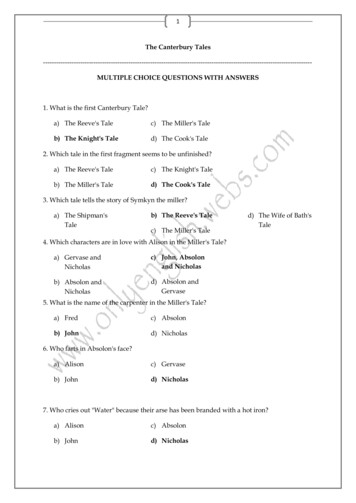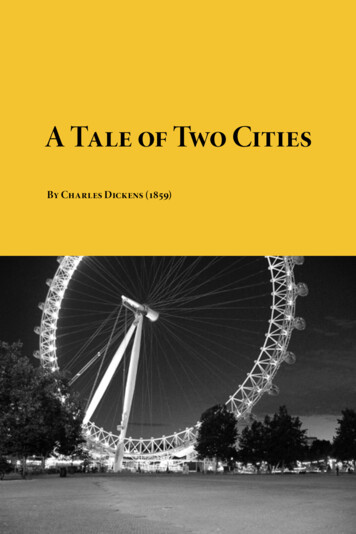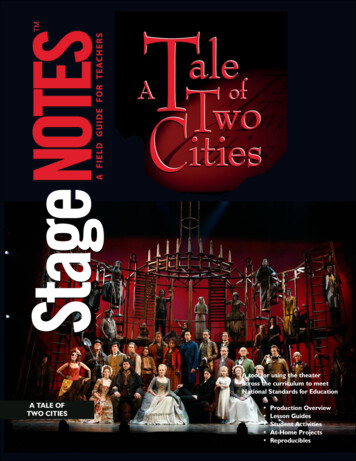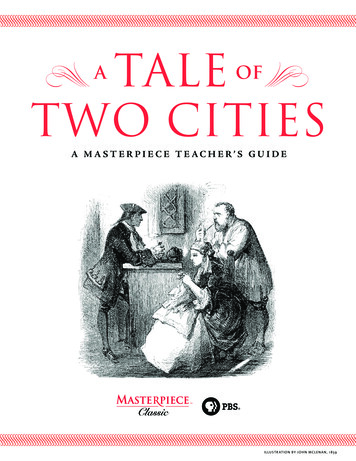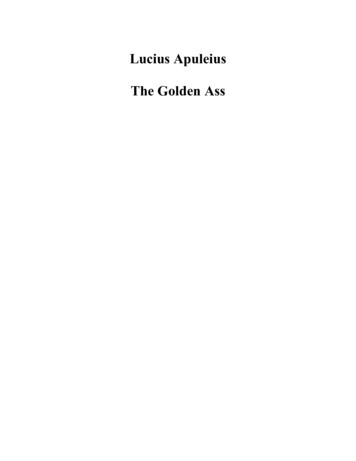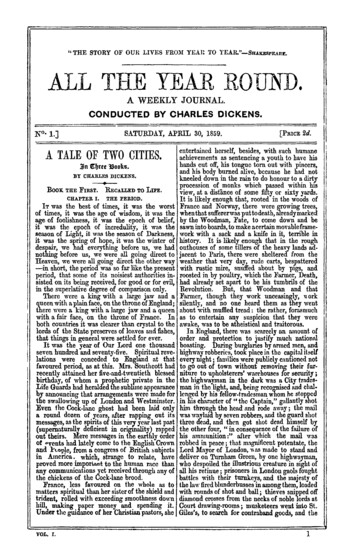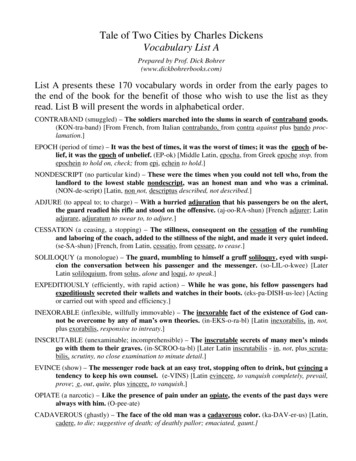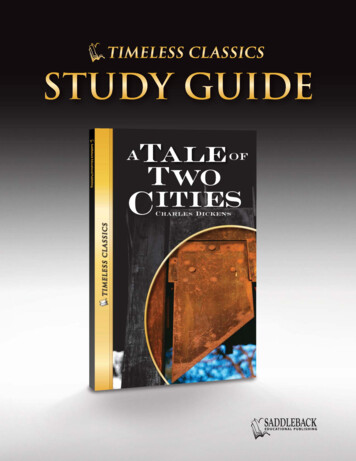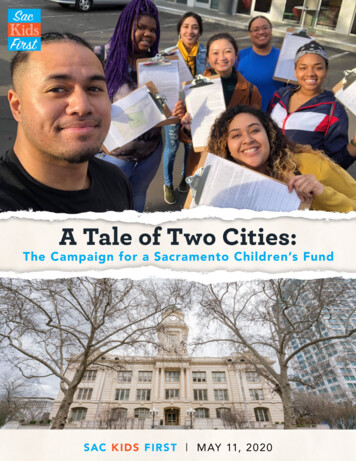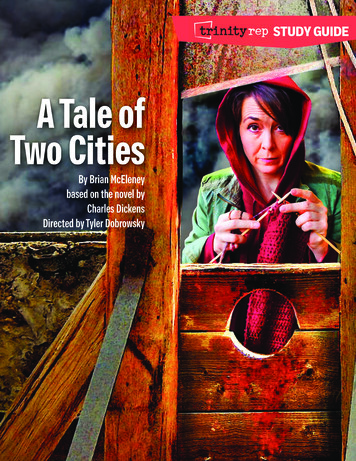
Transcription
STUDY GUIDEA Tale ofTwo CitiesBy Brian McEleneybased on the novel byCharles DickensDirected by Tyler Dobrowsky1
EducationTable of ContentsSponsored bySeason sponsored byTheater Audience Etiquette. 3Using the Guide in Your Classroom . 4Unit One: Background InformationA Conversation with the Director: Tyler Dobrowsky. 6About the Playwright & Director . 7Historical Context: Behind the Setting & The French Revolution. 8Plot Synopsis . 9Support for Trinity Rep’s education programscomes from the Dexter Donation Trust, TheNorman and Rosalie Fain Family Foundation,Phyllis Kimball Johnstone & H. Earl KimballFoundation, Mary Dexter Chafee Fund, TheMcAdams Charitable Foundation, RhodeIsland State Council on the Arts, Shakespearein American Communities, Textron CharitableFoundation, Theatre ForwardThe YawkeyFoundation, Otto H. York Foundation, and manyindividual donorsPrepared by Joi Wright & Trinity Rep’sEducation DepartmentDesigned by Jessica ThomasMajor Themes & Discussion Questions . 10Character & Cast. 12Conversation with the Director & Playwright. 13Biography of Dickens. 15Unit Two: Entering The TextWarm-Ups. 17One Word at a Time. 17Ten Second Objects. 18What Are You Doing? . 18Exercise 1: Love, Hate, and Ambivalence. 19Exercise 2: What’s in a Role? . 20Exercise 3: I’m Not Bad, I’m Just Drawn That Way. 20Exercise 4: Letters to a Character. 21Exercise 5: 101 Ways to Read a Monologue . 21Monologues . 22Scenes . 23Bibliography. 262
Theater Audience Etiquette & DiscussionPLEASE READ CAREFULLY AND GO OVER WITH YOUR CLASSES BEFORE THE SHOWTEACHERSDISCUSSION QUESTIONS BEFORE SEEING THE SHOW AT TRINITY REP:Speaking to your students abouttheater etiquette is ESSENTIAL.Students should be aware that this isa live performance and that theyshould not talk during the show. Ifyou do nothing else to prepare yourstudents to see the play, please takesome time to talk to them abouttheater etiquette in an effort to helpthe students better appreciate theirexperience. It will enhance theirenjoyment of the show and allowother audience members to enjoy theexperience. The questions below canhelp guide the discussions. Thank youfor your help and enjoy the show!What are the differences between live theater and cinema? (Two dimensionalvs. three dimensional; larger than life on the screen vs. life-size; recorded vs.live, etc.) Discuss the nature of film as mass-produced, versus the one-time onlynature of live performances. Talk about original art works vs. posters. Which dothey feel is more valuable? Why? What is the responsibility of an audience whenwatching a play? What is the responsibility of an audience when watching aShakespeare play?ETIQUETTEWhat is the role of the audience in alive performance? How is it differentfrom seeing a film? Why shouldn’tyou talk during the play? What canhappen in live theater that cannothappen in cinema?Reiterate that students may not talkduring the performance. Please makesure all cell phones and alarms areturned off. Recording devices andcameras are strictly prohibited. If thereis a disturbance, they will be asked toleave and the class may not be invitedback to the theater. Students may notleave the building during intermission.Observation #1When you get into the theater, look around. What do you see? Observe thelighting instruments around the room and on the ceiling. Look at the set. Does itlook realistic or abstract? Try to guess how the set will be used during the show.Observation #2Discuss the elements that go into producing a live performance: The lights, set,props, costumes, and stage direction. All the people involved in the “behindthe scenes” elements of the theater are working backstage as the play unfoldsbefore the students’ eyes. Tell them to be aware of this as they watch the show.Observe the lighting cues. How do special effects work? How do the actorschange costumes so fast?Pay attention to when you’re excited about something on stage. What excitedyou? Pay attention to when you’re bored. Why were you bored? What wouldyou have done differently to make the play more interesting? Actors in a liveperformance are very attuned to the audience and are interested in thestudents’ reactions to the play. Ask the students to write letters to the actorsabout the characters they played and to ask questions of the actors.Send these letters to: Trinity Repertory Company, c/o Education, 201 WashingtonSt., Providence, RI 02903 or email to: education@trinityrep.com.3
USING THIS STUDY GUIDE IN YOUR CLASSROOMA Letter from Associate Education Director Matt TibbsWelcometo Trinity Rep and the 54thseason of Project Discovery! The education staffat Trinity Rep had a lot of fun preparing thisstudy guide and hope that the activities includedwill help you incorporate the play into youracademic study. It is also structured to help youto introduce performance into your classroomthrough the following elements: COMMUNITY BUILDING IN YOUR CLASSROOM INSPIRATION AND BACKGROUND ON THE ARTIST ENTERING AND COMPREHENDING TEXT CREATING TEXT FOR PERFORMANCE PERFORMING IN YOUR CLASS REFLECTING ON YOUR PERFORMANCETrinity Rep’s Project Discovery student matinées help high school students inthe following common core areas (for more information on the National CoreArts Standards, visit http://nationalartsstandards.org/) Initiate and participate effectively in a ranges of collaborative discussions(one-on-one, in groups, and teacher-led) with diverse partners on grades9-10 topics, texts, and issues, building on others’ ideas and expressingtheir own clearly and persuasively (CCS.ELA-LITERACY.SL.9-10.1) Analyze how complex characters (e.g., those with multiple or conflictingmotivations) develop over the course of a text, interact with othercharacters, and advance the plot or develop the theme (CCSS.RL.9-10.3) Determine the meaning of words and phrases as they are used inthe text, including figurative and connotative meanings; analyze thecumulative impact of specific word choices on meaning and tone (CCSS.RL.9-10.44) Investigate how cultural perspectives, community ideas, and personalbeliefs impact a drama/theatre work (TH: Cn10.1.I.) Analyze and compare artistic choices developed from personalexperiences in multiple drama/theatre works (TH: Re8.1.I.) Respond to what is seen, felt, and heard in a drama/theatre work todevelop criteria for artistic choices (TH: Re7.1.I.) Evaluate and analyze problems and situations in a drama/theatre workfrom an audience perspective (TH: Re9.1.I)Enjoy the show!Matt Tibbs, Associate Education Director4
2019–20 Season at the Lederer Theater Centerunder the direction ofCurt ColumbusTom ParrishThe Arthur P. Solomon andExecutive DirectorSally E. Lapides Artistic DirectorA Tale of Two Citiesby Brian McEleney based on the novel by Charles DickensTHE ARTISTIC TEAMDirected by Tyler DobrowskyMusic Direction & Original Music by Joel ThibodeauSet Design by Eugene LeeCostume Design by Toni SpadaforaLighting Design by Kate McGeeSound Design by Peter Sasha HurowitzProduction Stage Managed by Kristen Gibbs*February 20 – March 22, 2020in the Elizabeth and Malcolm Chace TheaterSponsored byMany thanks to The Providence Public Libraryfor its assistance on this production.Trinity Rep’s 56th Season is sponsored bySupporting Season SponsorTHE CAST (in alphabetical order)Monsieur Defarge Stephen Berenson*‡Ensemble Rudy CabreraMarquis, Ensemble Matt Clevy*Mr. Lorry Tim Crowe*‡Ensemble Jackie Davis*Miss Pross, Ensemble Rachel Dulude*Sydney Carton Daniel Duque-Estrada*‡John Barsad, Ensemble Jotae FraserLucie Manette Rebecca Gibel*‡Charles Darnay Taavon Gamble*Doctor Manette Brian McEleney*‡Ensemble David RabinowMadame Defarge Rachael Warren*‡Musicians Christopher Sadlers, Joel ThibodeauA Tale of Two Cities is performed with one intermission.Production Director Laura E. SmithAssistant Stage Manager James Kane** Member of Actors’ Equity Association, the union of professional actors & stage managers‡ Trinity Rep Resident Acting Company memberTrinity Rep gratefully acknowledges the past support of the B.B. LedererSons Foundation, the State of Rhode Island, and the City of Providence.Southwest is the official airline of Trinity Rep.PICTURED ON THE COVER: RACHAEL WARRENCOSTUME BY AMANDA DOWNING CARNEY IMAGE BY MICHAEL GUYPLEASE TURN OFF cell phones and alarms during theperformance. Texting and cell phone use are limited to intermission,outside the theater. Photography, videotaping, and/or othervideo or audio recording of the performance by any means arestrictly prohibited.TRINITY REPERTORY COMPANY 201 WASHINGTON STREET PROVIDENCE RHODE ISLAND (401) 351-4242 WWW.TRINITYREP.COM35
Unit 1: BackgroundA Conversation with theDirector: Tyler DobrowskyJoi Wright: In your own words couldyou walk us through the story ofCharles Dickens’s A Tale of TwoCities?Tyler Dobrowsky: Basically there’s alove triangle between two guys thatlook exactly the same and a youngwoman named Lucie, and the lovetriangle happens during the FrenchRevolution when all the poor people ofFrance rose up and murdered all therich people. So.pretty exciting stuff!JW: Thus far, what excites youmost about this production ofA Tale of Two Cities?TD: What I love about this productionof A Tale of Two Cities is how fleet andactor-centric the adaptation is. It feelslike every actor on stage is telling thestory, and there is a real propulsiveenergy to it. We’re also not doing theplay traditionally, like it’s a period piece,but instead it has a real contemporaryfeel to it (particularly the sets andcostumes). The contemporary stuffdoesn’t feel intrusive, though — ratherit’s just removing a barrier that says,“This play is set so long ago, and it hasnothing to do with today.” Hopefullythis will make the play feel a bit moreimmediate to the audience (andparticularly the young people comingto see it!).6Tyler Dobrowsky , DirectorJW: What has been some of yourgreatest challenges thus far withworking on this production?TD: Yeah, those are definitely someresonant themes in the play. I wouldadd that, what I love about this pieceand why I think it’s important today, isTD: There is a fair amount ofthat it talks about political unrest andimaginative staging that has toupheaval and how that’s connected tohappen with this adaptation. Andeconomic and social inequality. When athat is mostly very exciting, but itsociety is unequal or unjust, it can onlyalso requires a lot of planning andsurvive for so long before it’s toppled.then a lot of thinking on your feet inand then what fills that vacuum? Oncethe rehearsal room. Plus, there aresomething is dismantled, what takesfourteen actors, a huge set by TonyAward-winner Eugene Lee, live music. its place? That’s certainly apparent inthe French Revolution, and I think it’sthere’s a lot going on! And truly it’sa worthy conversation to have today.all very thrilling, but there are a lot ofmoving pieces to keep track of! Luckily, Plus, I love how the book and the playI have some terrific actors and a great marry the larger political issues topersonal stories.stage management team.JW: Is there a particular characteror scene that you connect with inthis show, and why?TD: I like several scenes in the play,but the reunion between Lucie and herfather at the beginning and Carton’sspeech at the conclusion of the playare definitely standouts. I also loveall the original music written andperformed by Joel Thibideau.JW: The play seems to wrestle withsome major themes such as; socialinjustice, resurrection and sacrifice.What would you say are some majorthemes of this production?JW: What are you most excitedfor the students to see in yourproduction and what are somethings you would like a studentaudience to take away from thisproduction of A Tale of Two Cities?TD: I hope they like the staging andthe music and the story. I hope theyare taken on a ride, and see how funthis book and this play can be. Thestory itself is so fun and rich, andDickins’ language so vivid and heartfelt.so I hope the students get a kickout of all that. And then I hope theyenjoy it as a piece of theater, too!
About the Director& PlaywrightTyler Dobrowsky: DirectorBrian McEleney: PlaywrightTyler Dobrowsky has been a member of the education,literary, community engagement and artistic teams since2003. He oversees Trinity Rep’s new play developmentinitiatives, where he has commissioned writers such asGeorge Brant, Charise Castro-Smith, Jackie Sibblies Druryand Lauren Yee, as well as the New York Times best-seller,The Prince of Providence by Mike Stanton. He foundedTrinity Rep’s summer program for children, the Young ActorsSummer Institute (YASI), and, in partnership with RhodeIsland Latino Arts, created Teatro en el Verano, the theater’sfree, mobile, bilingual summer series. Directing credits atTrinity Rep include: Little Shop of Horrors; Into the Breeches!(world premiere); A Midsummer Night’s Dream; Romeo andJuliet (with Rhode Island Latino Arts); Julius Caesar; A Fleain Her Ear; A Christmas Carol; Love Alone (world premiere);and It’s a Wonderful Life. His work has also been seen atthe following theaters: ART/Oberon (upcoming); Asolo Rep;Elemental Theater; Gamm Theater; PlayMakers/UNC; ThePublic Theater. He has taught at NYU’s Tisch School forthe Arts, the Brown/Trinity Rep MFA program, RISD, andRhode Island College. Tyler serves on the board of RhodeIsland Latino Arts and is a proud member of the StageDirectors and Choreographers Union. He received his MAfrom Brown University and his BA from Holy Cross. He livesin Providence with his wife, Taibi.Trinity Rep/Actor: Over 75 plays, including King Lear,Richard II, Richard III, Julius Caesar, The Glass Menagerie, Edgar Allan Poe, Vanya and Sonia and Masha and Spike, TheOdd Couple, Who’s Afraid of Virginia Woolf?, The Cider HouseRules, Angels in America, Long Day’s Journey Into Night,The Merry Wives of Windsor, The Threepenny Opera, CherryOrchard, AmadeusDirector: Over 25 productions as Trinity Rep AssociateDirector, including Death of a Salesman, To Kill a Mockingbird,Blues for Mister Charlie, Ivanov, The Grapes of Wrath, House &Garden, Absurd Person Singular, The Crucible, Twelfth Night,The Dreams of Antigone, A Raisin in the Sun, All the King’sMen, Our Town,Hamlet, Measurefor Measure.Other: A graduateof Trinity Collegeand the YaleSchool of Drama,he is Head of theBrown University/Trinity Rep M.F.A.Acting ProgramBrian McEleney, Playwright7
Unit 1: BackgroundHistorical Context: Behind theSetting & The French RevolutionA Tale of Two Cities is an 1859 historical novel by Charles Dickens, set inLondon and Paris before and during the French Revolution. Dickens sets A Tale ofTwo Cities primarily in Paris and London during one of the most turbulent periodsof European history, the French Revolution. The novel covers events between1775 and 1793, referring also to incidents occurring before that time. The FrenchRevolution began in 1789 and continued in various forms through at least 1795.He did not concern himself with the revolution’s immediate political or economiccauses but focused on the human suffering that he believed warped the veryhumanity of individuals on both sides of the battle lines.The French Revolution began on May 5, 1789, when the Estates-General(representatives elected to represent the clergy, the nobility, and the rest of thepopulation) gathered together for the first time in more than 150 years. Mostof the French population was frustrated by heavy taxes and a political systemthat put virtually all power in the hands of aristocrats. Revolutionaries tried toseize power, which led to rioting and violence in Paris, and on July 14, 1789, theystormed the Bastille fortress. Many French aristocrats fled to other countries,including England, and French revolutionaries attacked and burned the homesof the wealthy. In August 1789, the Revolutionary government published theDeclaration of the Rights of Man, proclaiming a new vision of social andpolitical equality.Despite the hopes of creating a more just and equal society, violence andunrest continued. The French King and Queen were executed during a periodknown as the “Reign of Terror,” which lasted from 1793 to 1794. During thistime, anyone perceived as disloyal to the Revolutionary government could beimprisoned or executed. In total, more than 16,000 people were executed. Theviolence of the Revolution led other European countries to eventually declarewar against France. The Revolution finally came to an end when a Frenchgeneral named Napoleon was recognized as the leader of the French state. Thewars which began during the Revolution lasted until 1815, when Napoleon wasdefeated for the final time.8
Plot Synopsisby Audrey RowlandA Tale of Two Cities is a big story setin a sweeping world, where people trytheir best in a political and economicsystem that does not make it easy tobe a good person.soon have a daughter, Little Lucie.However, Lucie is still committed tohelping Carton cast off his bad habits,like over-drinking, and embrace hisbest self.In 1775, Lucie Manette is reunitedwith her father, the haunted Dr.Manette, newly released from theinfamous Bastille fortress. The pairflee France in crisis and share a boatwith the wry, but kind, Charles Darnayon their way to England. Five yearslater, when Darnay stands accused oftreason, Lucie and the Doctor attest tohis good character. After some skillfullegal maneuvering, Sydney Carton – aprison official and a known drunk –wins Darnay an acquittal, saving himfrom the death penalty.Meanwhile, in France, the lordMarquis runs into trouble of his own.After accidentally running over a childin his carriage, killing him instantly, theMarquis responds to the shock andhorror of the locals with disinterest.The next day, the Marquis is foundwith a knife in his heart and a note,written by the child’s father, Gaspard,taking responsibility for the lord’smurder. At the advice of MonsieurDefarge and his wife, Madame Defarge,prominent leaders in the FrenchRevolution, Gaspard resists arrest, andthe revolution begins in earnest.Despite Carton’s intercessionon Darnay’s behalf, and despite thestrange physical similarity betweenthe two men, Darnay and Cartonsoon realize that they do not care foreach other at all. They do, however,care deeply for Lucie Manette. Thisleads Darnay to propose, and toreveal his family secret: although hehas disowned his inheritance, he is amember of the elite Marquis family.Lucie accepts his proposal, and theyDarnay returns to France, wherehis true identity is discovered, andhe is arrested for his status as anaristocrat. At the trial, Monsieur andMadame Defarge use a note that Dr.Manette wrote in prison, condemningthe Marquis and his descendants asevidence against Darnay. Dr. Manette’spleas on behalf of Lucie’s husbandare ignored, and Darnay is sentencedto death. This devastates Lucie, butwith her daughter in mind, she isdetermined to save her family.Carton, Lucy’s former suitor, isdetermined to help her. With the helpof Barsad, one of his friends, Cartonsneaks into the jail where Darnayis held. The two switch clothes,and Carton drugs Darnay. Cartonremains behind in Darnay’s clothing,and a surprised Barsad carries theunconscious Darnay out of the prisonand back to his family. A shocked andgrateful Lucie, Darnay, and daughterreturn to England as quickly aspossible. Darnay’s escape heightenstensions within the revolutionarycamp, and Madame Defarge is killed.In response, Monsieur Defarge stopsthe search for Darnay and his family tomourn his loss.In the prison, a seamstress jailedalongside Darnay sees throughCarton’s deception and blesses himfor his sacrifice. Carton walks to theguillotine and reflects on the love thatLucie introduced to his life.9
Unit 1: BackgroundMajor Themes &Discussion QuestionsCOLLECTIVE GUILTSACRIFICEThe theme of collective guilt iscertainly present in A Tale of Two Cities.It is this concept that fuels the terrorthat Paris descends into during theFrench Revolution. We see it wieldedas a blunt instrument by the likesof Madame Defarge as she seeksrevenge on all members of the Frencharistocracy no matter how insignificanttheir own offenses may have been.The theme of sacrifice is most stronglyapparent in Sydney Carton’s decisionto take Charles Darnay’s place,even though doing so means beingexecuted. When the seamstress asksCarton if he is dying for the sake ofDarnay, Carton agrees, and adds “Andhis wife and child”. Carton’s love forLucie and her daughter encourageshim to sacrifice himself because herhappiness is more important thananything else. As a man who does nothave a family of his own, he placesmore value on Darnay’s life than on hisown. Carton is also aware that he haslived an unproductive and dissolutelife, and that he has not offered muchto the world. Carton believes that hisact of sacrifice will redeem everythingthat has come before, and make his lifemeaningful. As he reflects to himself,“It is a far, far better thing that I do,than I have ever done before”.DISCUSSION QUESTIONSWhen you experience guilt, do you tendto respond by making others pay for it,dismissing it, or hiding it? Why do youthink you respond the way you do?LOVEIt is love that reunites Lucie Manettewith a father she has never known.After Dr. Manette has been imprisonedin the Bastille for eighteen years, LucieManette learns that her father hasbeen freed. Both Darnay and Cartonalso love Lucie, and particularly Cartonsacrifices his life so that the woman heloves can be happy.DISCUSSION QUESTIONSIs this a prominent theme in a lot ofyoung adult content — books, film,music — where is it most seen?Does it seem like there are certainsocial expectations and pressuressurrounding love?10DISCUSSION QUESTIONSWhat does sacrifice mean to you?What are some sacrifices, big or smallthat you have made for the sake ofsomeone else?
11
Unit 1: BackgroundCharacters & CastMONSIEUR DEFARGESTEPHEN BERENSON12JACQUES 3, ENSEMBLERUDY CABRERAMARQUIS, ENSEMBLEMATTHEW CLEVYMR. LORRYTIM CROWEJACQUES 2, ENSEMBLEJACKIE DAVISMISS PROSS, ENSEMBLERACHEL DULUDESYDNEY CARTONDANIEL DUQUE-ESTRADAJOHN BARSAD, ENSEMBLEJOTAE FRASERLUCIE MANETTEREBECCA GIBELCHARLES DARNAYTAAVON GAMBLEDOCTOR MANETTEBRIAN MCELENEYJACQUES 2, ENSEMBLEDAVID RABINOWMADAME DEFARGERACHAEL WARREN
Unit 1: BackgroundA Conversation with the Director & PlaywrightBM: I’ve never really written a playbefore, so this project seemedfoolhardy and over-ambitious. Butas I thought about it I reflected thatI’ve been in over 25 versions of avery successful Dickens adaptation.[Former Artistic Director] Adrian Hall’s“fleet and fastpaced version” of AChristmas Carol was my model andmy inspiration to take this on. And ITyler Dobrowsky: What made youwas also encouraged by the knowledgewant to work on A Tale of Two Cities that all of Adrian’s adaptations forin particular?Trinity Rep were done for this companyBrian McEleney: I was looking to work of actors, in this particular aesthetic.I knew that I would have a group ofon a piece that I felt would resonatecollaborators who would understandin our particular moment in history.There is so much division and so much my vision for how this production couldcome to fruition. A lot of it isn’t on thepolitical tumult in our country and inpage; it depends on vigorous acting,the world in general, that I thoughtlively music, and inventive direction toDickens’ novel might have somethingmake it come to life.to say to us now. I’ve always lovedthis novel. The writing is passionateand poetic; the characters are full oflife and specificity, and the overallimpression you get from reading it iswhat it feels like to be caught up in theforce of history, of not knowing whatwill happen next or how it’s all goingto turn out. The confusion, the anxiety,the partisan hatreds, the danger — it’sall in there.Before Associate Artistic Director TylerDobrowsky began rehearsals for TrinityRep’s production of A Tale of Two Cities,adapted by resident acting companymember Brian McEleney, he talkedto Brian to find out more about hisinterest in the Charles Dickens classicand how he approached adapting thenovel to the stage.TD: You produced this at the BreadLoaf School of English two summersago. What did you learn from that?BM: I learned that it worked, forstarters. There’s virtually nothing inthis piece that doesn’t come fromDickens. I trusted the genius of hisstorytelling and the poetic power ofhis writing, and tried to not get in theway. I was encouraged to find thatnon-realistic staging let the audienceuse its imagination to create the worldof the play. And I learned that music isa tremendously important element ofthis piece; it lifts the language into thehigher realm of emotion and poeticismthat Dickens’ writing demands,and lends an air of contemporaryimmediacy to the production.TD: Your adaptation is remarkablyfleet and fast-paced, especiallyfor such a dense story, and it alsofeels of a piece with Trinity Rep’shistorically actor-driven aesthetic what was the process like turningsuch a classic text into a piece oftheater?13Brian McEleney in last season’sproduction of An Iliad
TD: You are also playing Doctor Manette in this production— which are you looking forward to most, working as thewriter/adaptor or working as an actor in the play?BM: I’m thrilled to be doing both! This is one of the wonderfulthings about being a member of the Trinity Rep acting company:you get opportunities that you would never have in otherinstitutions! The challenge of rewriting and editing during theprocess while at the same time playing a complex dramaticcharacter like Doctor Manette seems really exciting anddaunting! There are very few models for the process we’re aboutto enter, and — who knows? — it might turn out to be a disaster,and we’ll all wish I was only doing one job at a time. But it mayturn out to be wonderful; it will certainly be a great adventure. Atthe very least, I know I can count on your direction and support,as well as the support of all my colleagues in the acting companyand on the design team.TD: Anything else you want us to know about the show?BM: I certainly want to assure people that they won’t need tobe familiar with the novel to appreciate the production. And alsothat it won’t be a dusty museum piece. I was constantly thinkingabout our contemporary world as I wrote this adaptation andtried to make that come through in the writing. I hope it will!Set design; Inspired by the ProvidenceAthenaeum & designed by Eugene Lee14
Unit 1: BackgroundBiography of DickensIn his childhood, Charles Dickens (1812-1870) experienced first-hand theeffects of poverty and suffering. His early education was interrupted at the ageof twelve, when his father was sent to prison for debt. His entire family wasimprisoned at Marshalsea in London, and the young Charles was sent to workin a boot-blacking factory, alone and miserable, living and working in atrociousconditions. However, after three years Dickens was able to return to school,and from there he went on to become a clerk in a law office. In 1828 he startedworking as a freelance journalist, a job which eventually developed into theillustrious career as a well-known journalist, novelist, and playwright.Dickens achieved literary fame with novels such as David Copperfield, A Taleof Two Cities, and Great Expectations. These works focused on timeless themesthat spoke to the Victorian society as much as they do to modern readers: theimportance of friendship and family, helping the poor or suffering, and beingcompassionate to strangers and loved ones alike. These ideas were exploredthrough the social issues of his time, like poverty and child labor, using vivid andenchanting characters; Scrooge, Tiny Tim, Oliver, and the Artful Dodger are allstill memorable cultural symbols today. With the success of his writing career,
A Tale of Two Cities is performed with one intermission. Production Director Laura E. Smith Assistant Stage Manager James Kane* * Member of Actors' Equity Association, the union of professional actors & stage managers ‡ Trinity Rep Resident Acting Company member PLEASE TURN OFF cell phones and alarms during the performance.

